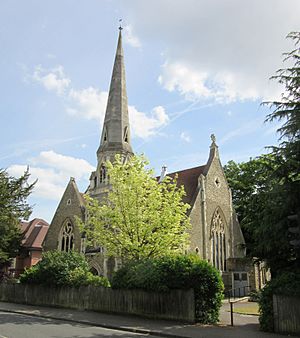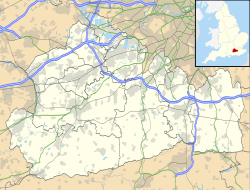Weybridge United Reformed Church facts for kids
Quick facts for kids Weybridge United Reformed Church |
|
|---|---|

The church from the northwest
|
|
| 51°22′05″N 00°26′47″W / 51.36806°N 0.44639°W | |
| Location | Queens Road, Weybridge, Surrey KT13 9UX |
| Country | England |
| Denomination | United Reformed Church |
| Previous denomination | Congregational |
| History | |
| Status | Church |
| Founded | 4 July 1864 |
| Founder(s) | Benjamin Scott, François Baron |
| Architecture | |
| Functional status | Closed 2022 (Merged with Walton-on-Thames congregation) |
| Heritage designation | Grade II |
| Designated | 24 October 1974 |
| Architect(s) | John Tarring |
| Style | Decorated Gothic Revival |
| Groundbreaking | 4 July 1864 |
| Completed | 17 May 1865 |
| Construction cost | £2,100 |
| Specifications | |
| Capacity | 350 |
| Materials | Rubble, ashlar |
| Administration | |
| Synod | Wessex Synod |
The Weybridge United Reformed Church is an old church building in Weybridge, England. It used to be called the Weybridge Congregational Church. This Victorian-era building is found on Queen's Road. It is a special building because it is a Grade II Listed site. This means it is important for its history and design.
The church was a place of worship for the United Reformed Church in Weybridge until 2022. In 2022, the church joined with another church in Walton-on-Thames. The two groups became one church called St Andrew's United Reformed Church Walton and Weybridge. They now meet in Walton-on-Thames. The Weybridge building is no longer used for church services.
This church was designed in 1864 by John Tarring. It opened in 1865. It has a special shape called "cruciform," like a cross. It also has a tall spire. Church services started in Weybridge in 1860. A man named Benjamin Scott helped make this happen. More and more people wanted to join, so they needed a bigger place. Scott bought the land for the church and helped pay for it.
The Weybridge church and the Walton church both joined the United Reformed Church group in 1972. They stayed as separate local churches for almost 50 years. Then, in 2022, they decided to merge.
Contents
History of the Church
Early Beginnings in Surrey
The first Congregational church in this part of Surrey started in Hersham in 1843. A small church building was finished the next year. Reverend A.E. Lord was the first minister there. He also traveled to other towns to preach. In 1855, he held services in a rented house in Weybridge for a few weeks. But he had to leave that place, and the church group struggled.
Benjamin Scott's Role
Five years later, in 1860, a man named Benjamin Scott moved to Weybridge. He was an important person in London. Scott started holding outdoor meetings on Sunday evenings. These were for people who were not part of the main Church of England. Many people were interested in his meetings. A local person let them use a room in their house for services during the week. These meetings continued until 1862.
Scott then made a room in his own house into a meeting place. Sunday evening services started there in January 1863. These meetings became very popular. Soon, they needed an even bigger room that could hold 200 people. Scott also became the first leader of the Surrey Congregational Union. This group helped manage Congregational churches in the area. Their first meeting was at Scott's home in June 1863.
Building the Church
By 1864, people decided that a permanent church building was needed. A Sunday school was also started that year. François Baron, another important person, had moved to Weybridge in 1863. He worked with Scott to start the new church. Scott bought the land on Queens Road. The first stone for the church was laid on July 4, 1864.
The architect John Tarring was chosen to design the church. It was finished the next year. The first service was held on May 17, 1865. François Baron became the first minister of the Weybridge Congregational Church on the same day. The church could hold 350 people. It cost about £2,100 to build. Benjamin Scott gave £500 and also donated the church organ.
Changes Over Time
A school building was opened in 1871. A church hall was added in the Oatlands area in 1891. François Baron moved to another church in 1890. Another minister was chosen right away. For some years, the Congregational church in Cobham was managed from Weybridge. The same happened for a church in Byfleet from 1902.
The church building itself was changed in 1886. A gallery was added inside. In 1965, for its 100th birthday, the inside of the church was changed a lot. A new pulpit was built, and a lectern was added. The organ's case was also moved.
In 1972, the Weybridge church became part of the new United Reformed Church group. This happened when most Congregational churches in England and Wales joined with the Presbyterian Church of England. Other church groups have joined since then. Today, there are about 1,500 United Reformed churches in the United Kingdom.
Church Design and Importance
The Weybridge United Reformed Church was built in a style called "Decorated Gothic Revival." This style looks like churches from the 14th century. The church is shaped like a cross, which is called "cruciform." It has a tower in the middle with a spire on top. The building is made of rough stone with smooth stone details. The roof is steep and covered with tiles.
The tower is square at the bottom. But the part where the bells are is shaped like a hexagon. The spire on top is also hexagonal. The church has a main area called the "nave" and a front part called the "chancel." There are also side parts called "transepts" on the north and south sides. The windows are tall and narrow, called "lancet windows." One expert, Nikolaus Pevsner, said the building looked "ferocious."
Inside the church, there are special plaques and memorials. These remember important people who helped the church. Benjamin Scott has a brass plaque. François Baron's memorial is near the main entrance. Samuel Woods, who was one of the first deacons (church helpers), has a memorial in the south transept. Other deacons, organ players, and church members are also remembered.
There are also carved heads inside and outside the church. Three of these heads are known to show John Greenwood, Henry Barrowe, and John Penry. These three men were important religious figures who died in 1593.
The Weybridge United Reformed Church was made a Grade II Listed building on October 24, 1974. Buildings with this listing are important to the country and have special historical or architectural value. In 2001, it was one of 462 Grade II listed buildings in its local area.
How the Church Was Run
The Weybridge United Reformed Church was officially registered as a place of worship. It was also registered to hold weddings starting in 1866. The church belongs to the Wessex Synod. This is one of 13 regional groups within the United Reformed Church. This group includes about 120 churches in different counties like Surrey, Hampshire, and Oxfordshire.
Before the merger, a church service was held every Sunday at 10:30 AM. The merged church now holds its services in Walton-on-Thames. The Weybridge church building also supported groups like Girl Guides and Scouts.
Joining with Walton-on-Thames
On January 1, 2022, the church in Walton-on-Thames and the Weybridge church joined together. They formed one new United Reformed Church for both towns. The Walton church had been Presbyterian until 1972, and the Weybridge church had been Congregational until 1972. Both became United Reformed churches in 1972.
The last church service in the Queen's Road, Weybridge building was held in August 2022. After that, the church group now meets only at the building in Hersham Road, Walton-on-Thames.
See also


